
Dalai Lama is a title given by Altan Khan, the first Shunyi King of Ming China. He offered it in appreciation to the leader of the Gelug school of Tibetan Buddhism, Sonam Gyatso, who received it in 1578 at Yanghua Monastery. At that time, Sonam Gyatso had just given teachings to the Khan, and so the title of Dalai Lama was also given to the entire tulku lineage. Sonam Gyatso became the 3rd Dalai Lama, while the first two tulkus in the lineage, the 1st Dalai Lama and the 2nd Dalai Lama, were posthumously awarded the title.
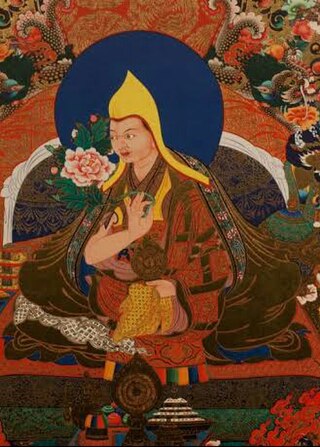
The 1st Dalai Lama, Gedun Drupa was a student of Je Tsongkhapa, and became his first Khenpo (Abbott) at Ganden Monastery. He also founded Tashi Lhunpo Monastery in Shigaste. He was posthumously awarded the spiritual title of Dalai Lama.

The 5th Dalai Lama, Ngawang Lobsang Gyatso was recognized as the 5th Dalai Lama, and he became the first Dalai Lama to hold both Tibet's political and spiritual leadership roles. He is often referred to simply as the Great Fifth, being the key religious and temporal leader of Tibetan Buddhism and Tibet. He is credited with unifying all of Tibet under the Ganden Phodrang, after Gushri Khan's successful military interventions. As an independent head of state, he established priest and patron relations with both Mongolia and the Qing dynasty simultaneously, and had positive relations with other neighboring countries. He began the custom of meeting early European explorers. The 5th Dalai Lama built the Potala Palace, and also wrote 24 volumes' worth of scholarly and religious works on a wide range of subjects.

The Gelug is the newest of the four major schools of Tibetan Buddhism. It was founded by Je Tsongkhapa (1357–1419), a Tibetan philosopher, tantric yogi and lama and further expanded and developed by his disciples.
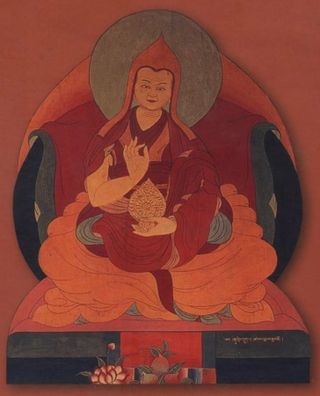
The 6th Dalai Lama, Tsangyang Gyatso, was recognized as the 6th Dalai Lama after a delay of many years, permitting the Potala Palace to be completed. He was an unconventional Dalai Lama that preferred a Nyingma school yogi's life to that of an ordained monk. He was later kidnapped and deposed by the Koshut Lha-bzang Khan.
The 10th Dalai Lama, Tsultrim Gyatso (full given name Ngawang Lobzang Jampel Tsultrim Gyatso or Tsultrim Gyatso was the 10th Dalai Lama of Tibet, and born in Litang, Kham. He was fully ordained in the Gelug school of Tibetan Buddhism, studied the sutras and tantras, had several students, and rebuilt the Potala Palace.
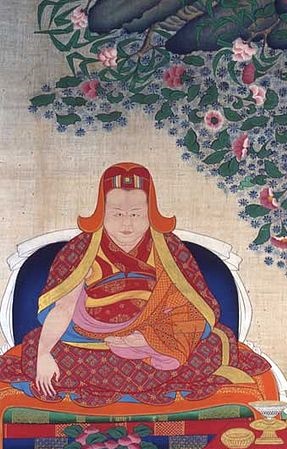
Yonten Gyatso or Yon-tan-rgya-mtsho (1589–1617), was the 4th Dalai Lama, born in Tümed on the 30th day of the 12th month of the Earth-Ox year of the Tibetan calendar. Other sources, however, say he was born in the 1st month of the Earth Ox Year.

The 13th Dalai Lama, Thubten Gyatso was the 13th Dalai Lama of Tibet, enthroned during a turbulent modern era. He presided during the Collapse of the Qing Dynasty, and is referred to as "the Great Thirteenth", responsible for redeclaring Tibet's national independence, and for his national reform and modernization initiatives.
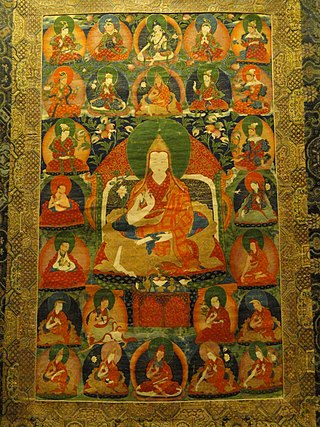
The 8th Dalai Lama, Jamphel Gyatso (1758–1804) was recognized as the 8th Dalai Lama of Tibet.

The 7th Dalai Lama, Kelzang Gyatso, was recognized as the authentic 7th Dalai Lama of Tibet. He was seen as the true incarnation of the 6th Dalai Lama, and was enthroned after a pretender supported by the Koshut Khan was deposed.

The 5th Dalai Lama, Ngawang Lobsang Gyatso was recognized as the 5th Dalai Lama, and he became the first Dalai Lama to hold both Tibet's political and spiritual leadership roles. He is often referred to simply as the Great Fifth, being the key religious and temporal leader of Tibetan Buddhism and Tibet. He is credited with unifying all of Tibet under the Ganden Phodrang, after Gushri Khan's successful military interventions. As an independent head of state, he established priest and patron relations with both Mongolia and the Qing dynasty simultaneously, and had positive relations with other neighboring countries. He began the custom of meeting early European explorers. The 5th Dalai Lama built the Potala Palace, and also wrote 24 volumes' worth of scholarly and religious works on a wide range of subjects.

Drepung Monastery, located at the foot of Mount Gephel, is one of the "great three" Gelug monasteries of Tibet founded by Je Tsongkhapa. The other two are Ganden Monastery and Sera Monastery. Drepung is the largest of all Tibetan monasteries and is located on the Gambo Utse mountain, five kilometers from the western suburb of Lhasa.
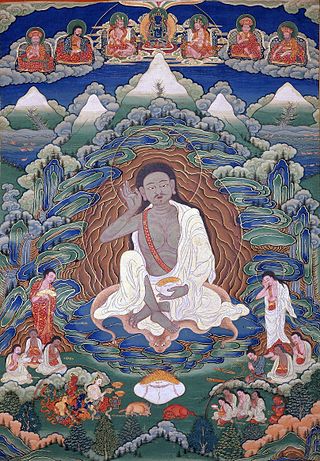
In Tibetan Buddhism and Bon, a ngakpa (male), or a ngakma (female) is any practitioner of Vajrayana who is not a monk or a nun. The terms translates to "man or woman of mantra" or "man or woman of secret mantra". They are often referred to as "householder yogis" or "yoginis" because they maintain a householder lifestyle while engaging in advanced tantric practices.

Kumbum Monastery, also called Ta'er Temple, is a Tibetan gompa in Lusar, Huangzhong County, Xining, Qinghai, China. It was founded in 1583 in a narrow valley close to the village of Lusar in the historical Tibetan region of Amdo. Its superior monastery is Drepung Monastery, immediately to the west of Lhasa. It is ranked in importance as second only to Lhasa.
Chokorgyel Monastery is a Buddhist monastery in Gyatsa County in Tibet, China.

Trülku Drakpa Gyeltsen (1619–1656) was an important Gelugpa lama and a contemporary of the 5th Dalai Lama (1617–1682). His Seat was the upper residence of Drepung Monastery, a famous Gelug gompa located near Lhasa.

The Kashag was the governing council of Tibet during the rule of the Qing dynasty and post-Qing period until the 1950s. It was created in 1721, and set by Qianlong Emperor in 1751 for the Ganden Phodrang in the 13-Article Ordinance for the More Effective Governing of Tibet. In that year the Tibetan government was reorganized after the riots in Lhasa of the previous year. The civil administration was represented by the Council (Kashag) after the post of Desi was abolished by the Qing imperial court. The Qing imperial court wanted the 7th Dalai Lama to hold both religious and administrative rule, while strengthening the position of the High Commissioners.
Yeshe Gyatso (1686–1725) was a pretender for the position of the 6th Dalai Lama of Tibet. Declared by Lha-bzang Khan of the Khoshut Khanate on June 28, 1707, he was the only unofficial Dalai Lama. While praised for his personal moral qualities, he was not recognized by the bulk of the Tibetans and Mongols and is not counted in the official list of the Dalai Lamas.
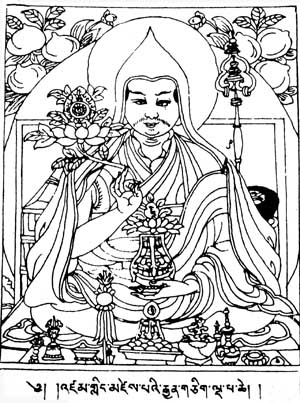
The Dual System of Government is the traditional diarchal political system of Tibetan peoples whereby the Desi coexists with the spiritual authority of the realm, usually unified under a third single ruler. The actual distribution of power between institutions varied over time and location. The Tibetan term Cho-sid-nyi literally means "both Dharma and temporal," but may also be translated as "dual system of religion and politics."

The Ganden Phodrang or Ganden Podrang was the Tibetan system of government established by the 5th Dalai Lama in 1642, when the Oirat lord Güshi Khan who founded the Khoshut Khanate conferred all spiritual and political power in Tibet to him in a ceremony in Shigatse. During the ceremony, the Dalai Lama "made a proclamation declaring that Lhasa would be the capital of Tibet and the government of would be known as Gaden Phodrang" which eventually became the seat of the Gelug school's leadership authority. The Dalai Lama chose the name of his monastic residence at Drepung Monastery for the new Tibetan government's name: Ganden (དགའ་ལྡན), the Tibetan name for Tushita heaven, which, according to Buddhist cosmology, is where the future Buddha Maitreya resides; and Phodrang (ཕོ་བྲང), a palace, hall, or dwelling. Lhasa's Red Fort again became the capitol building of Tibet, and the Ganden Phodrang operated there and adjacent to the Potala Palace until 1959.



















